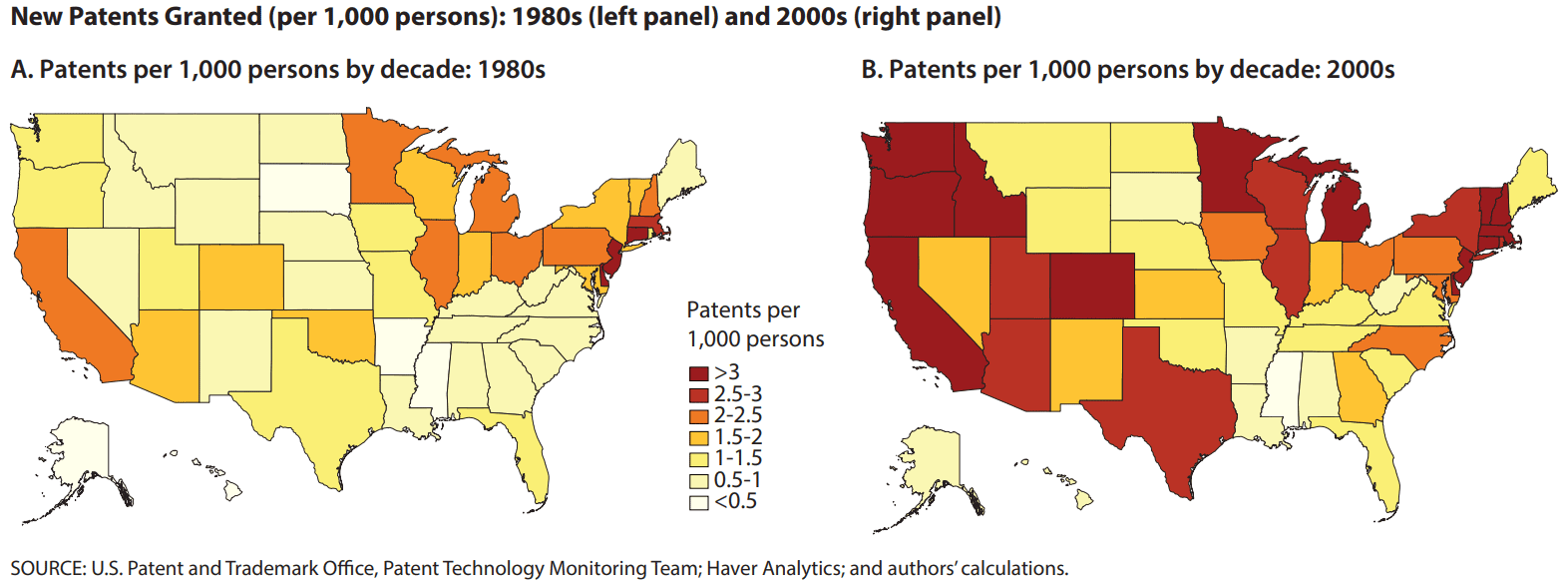How Innovation Has Shifted across the U.S.
The number of patents granted has grown rapidly in the United States since the 1980s. As one of the world’s innovation leaders, the U.S. had almost three times more patents granted in 2010 than in 1980, according to the U.S. Patent and Trademark Office.
In an Economic Synopses essay, St. Louis Fed Senior Economist Ana Maria Santacreu and Research Associate Jesse LaBelle examined state-level data on how patent generation has increased and why some geographic areas have outpaced others.
Regional Breakdown
Patent creation was concentrated in three U.S. regions in the 2000s, and those areas made up about 67% of total patents granted during that period, the authors noted. The regions were:
- Northeast: New York, New Jersey, Delaware and the New England states
- West Coast: Oregon, Washington, Idaho and California
- Rust Belt: Minnesota, Illinois, Michigan, Ohio and Pennsylvania
In contrast, Mississippi, Arkansas and Alaska were the least innovative states in the country, the authors pointed out.
Meanwhile, the gap between the most and least innovative states is wide. “The rate of patent creation in the most innovative state was 22 times larger than in the least innovative state,” Santacreu and LaBelle wrote.
Innovation on the Rise
The geographic distribution of innovation has changed over time, as shown in the figure below. Not only has the number of patents risen, but the pace of their creation has become more prevalent in the West.

Innovation typically spreads locally, and that’s why economic activity in innovative sectors is likely to cluster in geographic hubs, the authors noted. Examples of clustering can be found in the computer and technology industries in Western U.S. states.
“In the 1980s, the Rust Belt states dominated knowledge creation in the United States,” Santacreu and LaBelle said. “By the 2000s, they were replaced as innovation leaders by Western states. … Over this period, Western state patents went from an average of 1.4 per 1,000 persons to an average of 6.3 per 1,000 persons—an increase of 350 percent.”
As innovation and patents grew exponentially in the West, other regions did not experience the same expansion. From 1980 to 2010, the Rust Belt states went from averaging 2.2 patents per 1,000 people to 3.2 patents per 1,000 people—an increase of just 45% and well below that of the West.
Location Matters
In the study, Santacreu and LaBelle found that the distribution of innovation in the U.S. has become more concentrated, while also shifting to the Western part of the country. What might be causing this?
“First, the increase in geographic concentration and clustering of innovation suggests the presence of knowledge spillovers across U.S. states with innovation hubs, which is an important source of economic growth,” the authors concluded. “Second, this westward geographic shift of innovation reflects the sectoral shift of innovation toward the computers and electronics sector.”
Citation
ldquoHow Innovation Has Shifted across the U.S.,rdquo St. Louis Fed On the Economy, Dec. 6, 2021.
This blog offers commentary, analysis and data from our economists and experts. Views expressed are not necessarily those of the St. Louis Fed or Federal Reserve System.
Email Us
All other blog-related questions

